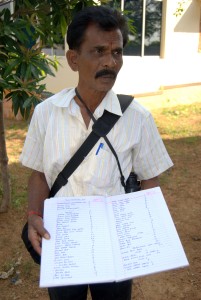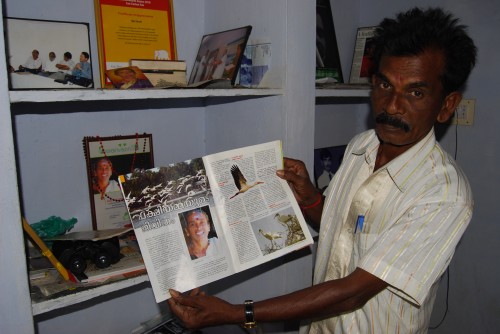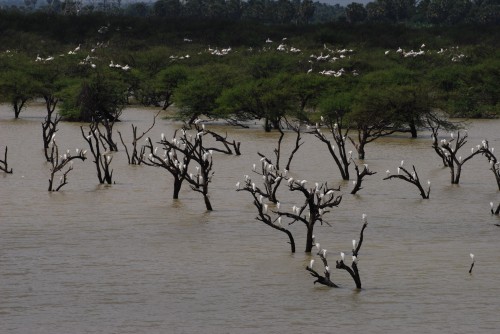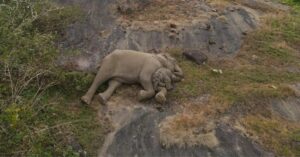Meet Bal Pandian: The Bird Man of Koonthakulam
“About 3,000 birds nest here in the peak season,” pointed out Bal Pandian as I panned my camera along the graceful flight of a flock of landing pelicans. I was
“About 3,000 birds nest here in the peak season,” pointed out Bal Pandian as I panned my camera along the graceful flight of a flock of landing pelicans. I was at the Koonthakulam Bird Sanctuary, with photographer and naturalist Balan Madhavan. Bal Pandian is an ordinary villager, but his extraordinary feats have made him a legend. Koonthakulam, close to the southern coast of Tamil Nadu not so far from Kanyakumari, is well-known for its exciting congregation of water birds, and for the man who has been instrumental in their protection for over three decades. Bal Pandian got interested in water birds as a youngster going fishing with his father. He grew up in an atmosphere in which villagers were culturally protective about nesting and wintering waterbirds, believing they are the harbingers of good rain, and benefiting from the nutrient-rich guano.

Taking this tradition to passionate heights, he and his wife Vallithai Pandian dedicated their life to avian conservation. This involved not only protecting birds against poaching, but also taking care of chicks that would periodically fall from nests because of storms or high winds. Pandian recalled one year when they had 63 young spotbilled pelicans, painted storks, openbill storks, and darters in their care, and spent nearly Rs 50,000 on feeding them. Impossible as this was with their meagre earnings, his wife sold off her jewellery including her mangalsutra, and initiated a women’s club to collect
money.
Pandian has helped many a naturalist, film-maker and photographer in their work on birds. When he was quite young, well-known ornithologist Salim Ali visited the village, and taught him and others a few things. He was subsequently employed in a couple of research projects in which he learnt bird names, though he later realised that he was paid much less than he deserved. He is now employed by the Forest Department to look after the sanctuary. Over the years, he and Vallithai have been given several awards, and well-known film-maker Suresh Elamon has made a lovely video on him.
Community action
The sanctuary comprises a couple of tanks spread over 129 ha. The area was earlier with the panchayat, but taken over by the Forest Department. The Department has erected a watchtower and dormitory, but protection of the birds seems more a result of community action. This is readily acknowledged by the Department on its website depicting the sanctuary.
The villagers’ interest and concern for birds is quite evident from the way they tolerate the nesting of over 5,000 painted storks and other birds in trees scattered through the village (outside the sanctuary area). In peak nesting season, the noise is deafening, and the messy droppings everywhere, yet, year after year the villagers go about their business like any ordinary settlement. Even while focusing on the Pandian couple, this community context is crucial to keep in mind.
Bal Pandian, Balan and I visited a number of wetlands and pasture lands around, finding pelican and other birds feeding or resting comfortably at several sites. There have been several earlier incidents of poachers being caught by villagers at these sites. At Koonthakulam itself, the conservation tradition is said to go back at least 200 years.
Log book of bird species
Over the decades, Pandian has studied nesting, feeding, and other behaviour of several species. He maintains a daily diary of species, numbers, nesting, and other key features that he observes. His checklist currently has 203 species. Matter-of-factly, he tells me, “Salim Ali says there is no nesting of blackwinged stilt, spotbilled duck,comb duck, Kentish plover, wood and pintail snipes, and other such birds in these areas, but I have observed nesting of all of these.” He mentions that between 500 and 1,000 flamingos also arrive here in winter, and that this is the southern-most point for barheaded geese.
While traditions of conservation have continued, Pandian is worried about the attitude of the younger generation. He laments the fact that the government has done little to promote livelihoods linked to conservation. I ask if there is any community-based tourism, he says no one has helped develop it. Balan and I remark that many houses in the village could easily integrate home-stays, if culturally appropriate and if the residents are given a bit of orientation. Birders who come to the village would then be able to get a variety of experiences, and villagers would benefit from the income.
Two years back, Vallithai Pandian passed away. With a mix of sadness and pride in his voice, Bal Pandian tells us, “before she died, she made me promise to dedicate the rest of my life to birds.” As we leave him at the edge of the sanctuary, there is no doubt in our minds that this is precisely what he will do.

This story made me
-
97
-
121
-
89
-
167
Tell Us More
We bring stories straight from the heart of India, to inspire millions and create a wave of impact. Our positive movement is growing bigger everyday, and we would love for you to join it.
Please contribute whatever you can, every little penny helps our team in bringing you more stories that support dreams and spread hope.




















